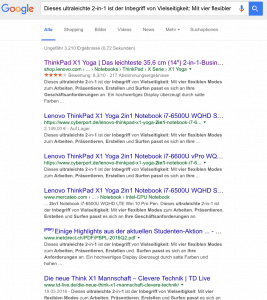Online shop owners often wonder how they can make the shopping experience as pleasant as possible for potential customers. Thus, much emphasis is placed on the visual presentation of products, product descriptions and product pages. The use of large format images or videos is becoming increasingly important.
In addition, visitors to the store are constantly measured in the background. Their click paths and mouse movements are evaluated. Based on the analyses, the UI (user interface) and on-page elements are permanently optimised.
All these efforts have one goal: to increase the rate of buying customers. The higher the conversion rate, the more often the online store’s cash register rings and the better the sales. But in addition to the purely technical consideration, an essential element of product pages is often neglected: the product description, i.e. the product text itself describing the product.
Search engines love good product descriptions
The SEO product description, i.e. good content about the product, is one of the most important factors for increasing the conversion rate – and thus sales. There are several reasons for this:
- Good product descriptions inform customers about the characteristics, features and added value of the product. Product descriptions with added value and tips tip the scales when in doubt. Especially when the customer is still unsure about the purchase.
- Product descriptions that are tailored to the needs of potential target groups create the necessary trust and provide interested parties with information about the product that is relevant to them and encourages them to buy.
- Thus, well-prepared product descriptions as a text type demonstrably contribute to a better ranking in the search results at the search engines, i.e. at Google. As a result, they also increase the conversion rate.
But a look at many a store shows all too often how carelessly the products and their features are described. This is because many online stores are content, for example, with listing product features in the form of short-winded bullet points or cryptic continuous texts with just a few words, instead of creating good articles that describe the product comprehensively and also use the right headings, subheadings and keywords for this purpose.
Even completely outdated data or even missing information are unfortunately a daily occurrence. Important questions of the readers are left unanswered. Added values such as tips, benefits or features of the product are also often missing. It could be even worse: Even overview pages often lead a shadowy existence or are filled with crude text. This discourages customers and, if in doubt, they prefer to forego the purchase or look around at the competition.
Product descriptions of the manufacturers are not a good alternative
Even worse: Many online shop owners, in their precarious situation, default to the product descriptions provided free of charge by the manufacturer. However, this content brings fatal consequences.
Let’s put it to the test. Let’s take an excerpt from any producer’s product description and do a Google search. The result is frightening: there are over 3,200(!) hits. These include a considerable number of online shops. As a result, any individuality and uniqueness falls by the wayside. For this reason, many online stores sink in the search engine in the uniform mush of identical search results. We can deduce three things from the example:
- The use of manufacturers’ product descriptions in stores robs operators of any chance of positioning themselves. Moreover, the individual approach to the target group suffers as a result.
- In short: Those who increasingly use manufacturers’ product descriptions expose themselves to a risk that should not be underestimated. the Google search algorithm does not like the multiple use of so-called duplicate content at all. Thus, a generally worse ranking in the search results is the consequence.
- Using manufacturers’ product descriptions weakens the conversion rate instead of increasing it.
Conversion-strong product descriptions not without effort
There are numerous reasons why product descriptions are neglected. For online retailers, creating product descriptions that appeal to clientele, are unique (uniqueness), and therefore SEO-relevant, presents some challenges:
- Speed: A lot of time passes until the descriptions are created. Thus, SEO-relevant product descriptions can often only be added to the product when its half-life has long since passed.
- Quality: The production quality of externally commissioned texts and descriptions is – to say the least – often subterranean. Furthermore, the requirements of conversion-strong and SEO-relevant text have not been fulfilled at all. On top of that, all too often you purchase product descriptions with orthographic and grammatical inadequacies. It takes a lot of extra time to eradicate the errors.
- Effort: Producing your own SEO-relevant product descriptions of high quality is a costly and high-maintenance affair. In low-margin online business, however, the retailer must think cost-effectively.
- Sustainability: The constant maintenance of category pages is often ignored and not carried out at all. The effort required by the constantly changing product range is simply too high. Product pages and overview pages are often completely forgotten.
Good product descriptions demonstrate their effectiveness
But no matter how you look at it, one thing remains undisputed: good product descriptions have an impact and boost sales with their benefits. To achieve this, the target group must be addressed accurately and with good content. The adequate tonality of the texts helps in this case. With SEO-relevant product descriptions, the cash registers will ring much more often, because visitors and those willing to buy will find the right product. The reason for this is an increased conversion rate. The next post will explain how the challenges described above can be met efficiently, sustainably and economically by using a Text Robot.
Further contributions on the topic of Text Robots:


